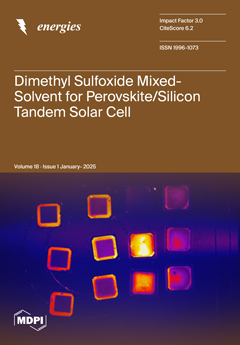With the increasing demand for thermal management in electronic devices and industrial systems, nanofluids have emerged as a research hotspot due to their superior thermal conductivity and heat transfer efficiency. Among them, CuO-H
2O demonstrates excellent heat transfer performance due to its
[...] Read more.
With the increasing demand for thermal management in electronic devices and industrial systems, nanofluids have emerged as a research hotspot due to their superior thermal conductivity and heat transfer efficiency. Among them, CuO-H
2O demonstrates excellent heat transfer performance due to its high thermal conductivity, Fe
3O
4-H
2O offers potential for further optimization by combining thermal and magnetic properties, and Al
2O
3-H
2O exhibits strong chemical stability, making it suitable for a wide range of applications. These three nanofluids are representative in terms of particle dispersibility, thermal conductivity, and physical properties, providing a comprehensive perspective on the impact of nanofluids on microchannel heat exchangers. This study investigates the heat transfer performance and flow characteristics of various types and volume fractions of nanofluids in microchannel heat exchangers. The results reveal that with increasing flow rates, the convective heat transfer coefficient and Nusselt number of nanofluids exhibit an approximately linear growth trend, primarily attributed to the turbulence enhancement effect caused by higher flow rates. Among the tested nanofluids, CuO-H
2O demonstrates the best performance, achieving a 4.89% improvement in the heat transfer coefficient and a 1.64% increase in the Nusselt number compared to pure water. Moreover, CuO-H
2O nanofluid significantly reduces wall temperatures, showcasing its superior thermal management capabilities. In comparison, the performance of Al
2O
3-H
2O and Fe
3O
4-H
2O nanofluids is slightly inferior. In terms of flow characteristics, the pressure drop and friction factor of nanofluids exhibit nonlinear variations with increasing flow rates. High-concentration CuO-H
2O nanofluid shows a substantial pressure drop, with an increase of 7.33% compared to pure water, but its friction factor remains relatively low and stabilizes at higher flow rates. Additionally, increasing the nanoparticle volume fraction enhances the convective heat transfer performance; however, excessively high concentrations may suppress heat transfer efficiency due to increased viscosity, leading to a decrease in the Nusselt number. Overall, CuO-H
2O nanofluid exhibits excellent thermal conductivity and flow optimization potential, making it a promising candidate for efficient thermal management in MCHEs. However, its application at high concentrations may face challenges related to increased flow resistance. These findings provide valuable theoretical support and optimization directions for the development of advanced thermal management technologies.
Full article





